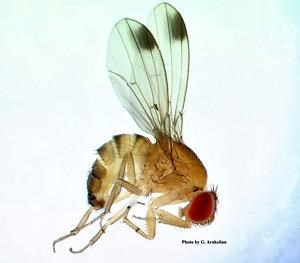An interesting dilemma has arisen in the community’s fruit-growing world. Whether it is a single cherry tree in a backyard or blueberries, blackberries, raspberries, plums and grapes on a farm or in the wild, this season gardeners in Powell River have seen the appearance of one, possibly two, invasive fruit fly species.
Upon getting the first reports back in mid-summer of grubs in cherries, Margaret Cooper, president of Powell River Garden Club, suspected it was the Western cherry fruit fly (Rhagoletis indifferens) (CFF). She ran a viewpoint in the Peak alerting the public and trying to map its occurrence.
“Within a day of the article [appearing],” she said, “I had an email from an entomologist from the University of Washington in Wenatchee, saying make sure you know what you are dealing with, it might be the spotted wing drosophila.”
Pretty soon grubs were found in other fruit too. Cooper began collecting samples of fruit flies and infested fruit to send to BC ministry of agriculture entomologist Tracy Hueppelsheuser, who confirmed that spotted wing drosophila (Drosophila suzukii) (SWD) is indeed in the Powell River area.
This fruit fly is very invasive because it hosts on all soft-skinned fruit and has many breeding cycles per season. “This pest is manageable, but it does take diligence by the growers, managers, harvesters and processors,” Hueppelsheuser responded.
Cooper’s map survey revealed it is already widely established here, with infested fruit being reported from Southview to Donkersley roads and all points in between.
Every kitchen and compost bin in the area was no doubt inhabited by common fruit flies (or vinegar flies) over the summer. The common fruit fly just feeds on decaying fruit, but the SWD lays its eggs in ripening fruit, damaging it on the tree. The young then feed upon the flesh of the fruit before emerging, up to two weeks later, as flies which right away carry on the egg-laying cycle for another generation.
A good rule everyone can remember is “pick early, pick often, pick clean,” said Hueppelsheuser. Pick fruit as soon as it is ready, not overripe; pick often, keep going back; and pick clean so nothing is left for the pests to breed in at the end of the season.
Cooper believes the CFF is also in the area. “We strongly suspect it is also here, but we do not have a positive identification,” she said. “We have to catch a fly next season to be sure.”
To assist the public in understanding the threat these flies pose to fruit growing in the Powell River area, and to help growers be ready to protect their crops next season, Cooper and her colleague Jo Canning, a master gardener, will host an informational evening starting at 7 pm on Monday, October 28 in the Evergreen Theatre at Powell River Recreation Complex. They will have lots of information about the fly and how to deal with it. They will give advice for an integrated pest management program and provide resource information about nets and sprays, where to get needed supplies and about services that are available to support growers. For organic growers, they may consider a spinosid group spray that is approved for use in organic lots. Cooper and Canning will be providing a timeline about what can be done at what time over the next few months leading up to summer.
Cooper appreciates that City of Powell River has provided the theatre for the event. “I went to see the mayor, and he had director of parks and recreation, Bill Reid, present as well,” she said. “They were very concerned and supportive.”
Powell River Regional District is also supporting the event. A recommendation to provide funds for advertising is on the agenda for the October 24 regional board meeting.
SIDEBAR
Serious pests identifiable and manageable
Spotted wing drosophila (SWD) is sometimes referred to as the Asian vinegar fly or Asian fruit fly. It arrived in California from Asia and Hawaii in 2008, and in these five years has spread all over North America, including Powell River.
The male can be identified by a black spot at the tip of each wing. This is easy to see with a magnifying glass. The female is much harder to differentiate, having no spots (just like the common fruit fly) but instead having a serrated egg-laying device, the ovipositor. With this she is able to cut through the skin of fruit and lay her eggs inside.
The Western cherry fruit fly is larger, about the size of a small house fly, with uniquely striped wings. It also lays its eggs in the ripening fruit and causes the fruit to rot on the tree, but it attacks only cherries, all kinds of cherries. It can be managed using methods similar to those used for the SWD.
Both species can be managed, but management requires vigilance of all property owners in the area.



